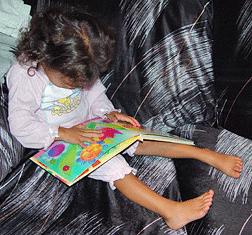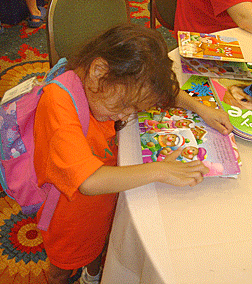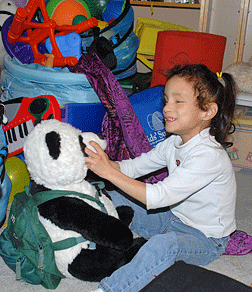Braille for My Baby: Six Things You Can Do at Home for Your Young Blind Child

by Graciela Tiscareño-Sato
Milagro, age three, feels very grown up as she “reads” Ten Little Ladybugs with braille labels.I remember the scene like it was just this morning: my six-month-old daughter sitting in my lap, “reading” Touch and Feel Wild Animal Babies. It was our first board book and my first time reading to my first-born child. I hadn’t yet heard of books for infants with braille in them so it was just a regular touch-and-feel type book I had picked up in the bookstore the day before.
We got to the smooth dolphin skin and she started moving about excitedly, as if she had made a great discovery. She moved her face to the book to smell the surface she was touching. I just sat there and let her explore the book however she wanted. When I turned the page to the bumpy lizard skin, I thought she was going to fall off the chair with excitement.
 What a find! Milagro gets into the spirit of the Braille Book Fair at the 2008 NFB Convention.It was at that moment that I committed myself to reading to her every night, even though she was blind. It seems so silly to me now that I had that thought back then--what did I mean, “even though she was blind?” What was I thinking? But that’s how it was. I’m not sure I had gained my perspective yet after enduring nearly five months in the NICU, five surgeries, and having her home just a few months after her severely premature birth (and eighteen-ounce birth weight).
What a find! Milagro gets into the spirit of the Braille Book Fair at the 2008 NFB Convention.It was at that moment that I committed myself to reading to her every night, even though she was blind. It seems so silly to me now that I had that thought back then--what did I mean, “even though she was blind?” What was I thinking? But that’s how it was. I’m not sure I had gained my perspective yet after enduring nearly five months in the NICU, five surgeries, and having her home just a few months after her severely premature birth (and eighteen-ounce birth weight).
Three months later at my request, my Blind Babies Foundation counselor arranged a lunch for me with a woman who had a blind daughter attending Stanford University, just across the Bay from my home. We met at a café in Berkeley so I could ask my ton of questions to a mom who had already raised a blind daughter. I remember Meb walking in with an armful of books, catalogs, and magazines--everything I needed to start bringing books in braille into my home. It was that day that I signed up with Seedlings Braille Books for Children and ordered my daughter’s first dozen braille board books (including her favorite Touch and Feel Wild Animal Babies). We were off. We had (thankfully) entered the world of early braille skills development for my infant, an effort that has paid dividends as she begins to establish more advanced literacy skills at the age of seven.
“She has excellent tracking skills,” I hear at IEP meetings.
“We usually have to work really hard to get little ones to track well but she just does it so naturally,” is another favorite comment I love to hear.
How does this work? Milagro checks out the Mountbatten Brailler at the NFB Convention exhibit hall. How did we get here? How did we get baby Milagro ready to learn braille, to track lines of braille well, and to enjoy writing braille and reading her own stories?
Here are the things we did at home long before she started formal braille lessons at the age of three:
Acquired a dozen touch-and-feel and scratch-and-sniff books. Very early on, we committed to the joy of reading with our young child, a joy we didn’t want to miss out on just because she didn’t see the pictures. She very much learned and appreciated the concepts associated with books, page turning, and just enjoying the reading experience. Some of our favorites are published by DK (Dorling Kindersley). They’re available in major book stores and through www.dk.com.
Learned the braille code ourselves. We got some little wooden tiles of the braille alphabet from a lovely man in Florida. We used them to quiz each other on the code, like a weird form of Scrabble for mom and dad. We attended a one-day braille workshop for families at the California School for the Blind. We signed up for the free online courses through the Hadley School for the Blind.We got the Just Enough to Know Better: a braille primer book from The National Braille Press. It contains a large pull-out braille sheet of the braille alphabet and braille contractions. We taped it to the back of the bathroom door. Seeing the braille code five-minutes at a time is a great way to start. Having an entire book dedicated to teaching braille to families is a must-have resource. It’s available at www.nbp.org or by calling toll-free (800) 548-7323.
We got a Perkins Brailler so we could produce little labels to put around the house when she learned to walk. Our teacher of the visually impaired (TVI) at the local preschool, Sue Douglass, provided this to us and showed us how to load paper, un-jam the machine, etc. Labels we created first were: light, table, high chair, bathtub, door, diaper changing table, drum, doll (taped on forehead), sink, rocking horse, potty, crib, and window.
We simply brailled them on card stock paper, cut them out, and taped them to the corresponding objects around the house. Some of those labels are still there. I remember Sue telling me, “It’s important that she not only touch the braille around the house, but that she begins to associate the bumps with meaning.” As she went to the sink to wash her hands, we took a moment to show her the braille label, run her fingers over the word, and say, “sink.” Eventually, she started echoing the word back to us. After that she would approach the tag herself to ‘read’ it. This was a very important thing that we did for her and I highly recommend it. Another way to accomplish the same thing is to ask a TVI [or a braille-proficient blind adult from the Federation] to create the labels for you. They can usually do this on special adhesive labels that stay up longer than our paper versions.
One tip: get Dr. Penny Rosenblum’s color-coded sheet and use it to code the keys on the brailler (Braille Alphabet Colored In and Braille Alphabet Blank Doc to Color In ). It makes writing so much faster for us sighted parents. Additionally, it’s a terrific way for siblings and friends to be able to easily type their names, notes for the blind child, and so forth.
If you can’t get a Perkins Brailler, there is always the trusty low-tech slate and stylus. It fits easily in your purse and lets you make quick shopping lists with your toddler. This way, she can enjoy shopping with you and touch braille with a purpose. (This gets even more fun when kids get older and can read the shopping list to you.) We got ours at the NFB store when we visited NFB headquarters in Baltimore. You can buy them online at the NFB Independence Market at https://nfb.org/independence-market. If you want to start writing with the slate and stylus immediately, get the two-page reference sheet designed specifically for this purpose. I still keep copies of this reference sheet with my slate and stylus in my purse because it’s so portable.
We got the Braille Book Bag from National Braille Press that contains braille magnet letters, books, a booklet, and many other items. Our Blind Babies Foundation counselor arranged this for us and it’s been a great braille toy set and resource for our family. Of course siblings and visiting children also inquire about the braille on the magnetic letters so it’s quite the conversation piece. See The Read Books! Program for more information.
 We introduced our child to Perkins Panda and his books and music. Our Blind Babies Foundation counselor brought the complete Perkins Panda collection produced by the Perkins School for the Blind into our home when Milagro was about eighteen-months old. It included books, tapes (narration and music), and a large stuffed toy bear named Perkins Panda. It was a great way to reinforce body parts with a stuffed toy bear that has many different textures on his body, that are all matched within the Perkins book called Belly Button. Today at the age of seven, she can read many of the words in these books herself. She says “I love you Perkins Panda” and sleeps with him.
We introduced our child to Perkins Panda and his books and music. Our Blind Babies Foundation counselor brought the complete Perkins Panda collection produced by the Perkins School for the Blind into our home when Milagro was about eighteen-months old. It included books, tapes (narration and music), and a large stuffed toy bear named Perkins Panda. It was a great way to reinforce body parts with a stuffed toy bear that has many different textures on his body, that are all matched within the Perkins book called Belly Button. Today at the age of seven, she can read many of the words in these books herself. She says “I love you Perkins Panda” and sleeps with him.
Started bringing Braille board books into our home. Seedlings Braille Books for Children and the Braille Institute in Los Angeles have been our primary resources. Both give away braille books for free on a regular basis in addition to maintaining catalogs from which we order. Seedlings has their Anna’s Angels program: www.seedlings.org; Braille Institute has their Dots for Tots program, see www.brailleinstitute.org or call toll-free (800) 272-4553 for details. There are others as well. Most of the Dorling Kindersley Touch-and-feel books mentioned earlier are available with braille labels from Seedlings too. The important thing to us is that we committed to reading with our child every night. We have three children now and made the same commitment to each of them.
All of this effort paid off for us on the last day of kindergarten as the class showed off their newly acquired reading skills. On that day, in her general education classroom, Milagro stood up and read “The Bumblebee,” a favorite poem, in front of her entire class of peers and their parents. The cheers from the audience when she finished and the smile on her face are priceless memories for me. Not only was it fun to watch, but it was validation that all those early actions we took at home were indeed valuable to get her started down the path of literacy.
This article first appeared in Future Reflections, Volume 28 Number 1 (2009) and is reprinted here with permission of the author.

Comments
E brailler or similar
Mountbatten Brailler